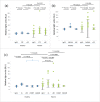Identification of human IgG1 variant with enhanced FcRn binding and without increased binding to rheumatoid factor autoantibody
- PMID: 28387635
- PMCID: PMC5524163
- DOI: 10.1080/19420862.2017.1314873
Identification of human IgG1 variant with enhanced FcRn binding and without increased binding to rheumatoid factor autoantibody
Abstract
Various studies have demonstrated that Fc engineering to enhance neonatal Fc receptor (FcRn) binding is effective for elongating half-life or increasing cellular uptake of IgG. A previous study has shown that a N434H mutation to enhance FcRn binding resulted in increased binding to rheumatoid factor (RF) autoantibody, which is not desirable for therapeutic use in autoimmune disease. In this study, we first showed that all the existing Fc variants with enhanced FcRn binding also show increased RF binding, and then identified specific mutations that could be introduced to those Fc variants to reduce the RF binding. Furthermore, we generated novel Fc variants that do not increase RF binding and show half-lives of 45 d in cynomolgus monkey, which is longer than those of previously reported Fc variants. In addition, we generated novel Fc variants with antigen sweeping activity that do not increase RF binding. We expect that these novel Fc variants will be useful as antibody therapeutics against autoimmune diseases.
Keywords: Antibody therapeutics; CH2-CH3 interface; Fc engineering; FcRn; RF; pharmacokinetics; pre-existing ADA; rheumatoid factor; sweeping antibody.
Figures




Similar articles
-
Global conformational changes in IgG-Fc upon mutation of the FcRn-binding site are not associated with altered antibody-dependent effector functions.Biochem J. 2018 Jul 5;475(13):2179-2190. doi: 10.1042/BCJ20180139. Biochem J. 2018. PMID: 29794155
-
The neonatal Fc receptor (FcRn) binds independently to both sites of the IgG homodimer with identical affinity.MAbs. 2015;7(2):331-43. doi: 10.1080/19420862.2015.1008353. MAbs. 2015. PMID: 25658443 Free PMC article.
-
Cross-species analysis of Fc engineered anti-Lewis-Y human IgG1 variants in human neonatal receptor transgenic mice reveal importance of S254 and Y436 in binding human neonatal Fc receptor.MAbs. 2016 May-Jun;8(4):775-86. doi: 10.1080/19420862.2016.1156285. Epub 2016 Mar 30. MAbs. 2016. PMID: 27030023 Free PMC article.
-
Neonatal Fc receptor (FcRn): a novel target for therapeutic antibodies and antibody engineering.J Drug Target. 2014 May;22(4):269-78. doi: 10.3109/1061186X.2013.875030. Epub 2014 Jan 9. J Drug Target. 2014. PMID: 24404896 Review.
-
The structure of a human rheumatoid factor bound to IgG Fc.Adv Exp Med Biol. 1998;435:41-50. doi: 10.1007/978-1-4615-5383-0_4. Adv Exp Med Biol. 1998. PMID: 9498063 Review.
Cited by
-
Recent Advances in Translational Pharmacokinetics and Pharmacodynamics Prediction of Therapeutic Antibodies Using Modeling and Simulation.Pharmaceuticals (Basel). 2022 Apr 22;15(5):508. doi: 10.3390/ph15050508. Pharmaceuticals (Basel). 2022. PMID: 35631335 Free PMC article. Review.
-
Human IgG Fc-engineering for enhanced plasma half-life, mucosal distribution and killing of cancer cells and bacteria.Nat Commun. 2024 Mar 7;15(1):2007. doi: 10.1038/s41467-024-46321-9. Nat Commun. 2024. PMID: 38453922 Free PMC article.
-
Long lasting neutralization of C5 by SKY59, a novel recycling antibody, is a potential therapy for complement-mediated diseases.Sci Rep. 2017 Apr 24;7(1):1080. doi: 10.1038/s41598-017-01087-7. Sci Rep. 2017. PMID: 28439081 Free PMC article.
-
Antibody engineering to generate SKY59, a long-acting anti-C5 recycling antibody.PLoS One. 2018 Dec 28;13(12):e0209509. doi: 10.1371/journal.pone.0209509. eCollection 2018. PLoS One. 2018. PMID: 30592762 Free PMC article.
-
Impact of antibody Fc engineering on translational pharmacology, and safety: insights from industry case studies.MAbs. 2025 Dec;17(1):2505092. doi: 10.1080/19420862.2025.2505092. Epub 2025 Jul 7. MAbs. 2025. PMID: 40624840 Free PMC article. Review.
References
-
- Kalden JR, Burkhardt H. Autoimmune disease: Treatment. Encyclopedia of Life Sciences 2009; https://doi.org/10.1002/9780470015902.a0001437.pub2 - DOI
-
- Rosman Z, Shoenfeld Y, Zandman-Goddard G. Biologic therapy for autoimmune diseases: An update. BMC Med 2013; 11:88; PMID: 23557513; https://doi.org/10.1186/1741-7015-11-88 - DOI - PMC - PubMed
-
- Chan AC, Carter PJ. Therapeutic antibodies for autoimmunity and inflammation. Nat Rev Immunol 2010; 10:301-16; PMID: 20414204; https://doi.org/10.1038/nri2761 - DOI - PubMed
-
- Wang D, Li Y, Liu Y, Shi G. The use of biologic therapies in the treatment of rheumatoid arthritis. Curr Pharm Biotechnol 2014; 15:542-8; PMID: 25213363; https://doi.org/10.2174/138920101506140910150612 - DOI - PubMed
-
- Lycke J. Monoclonal antibody therapies for the treatment of relapsing-remitting multiple sclerosis: Differentiating mechanisms and clinical outcomes. Ther Adv Neurol Disord 2015; 8:274-93; PMID: 26600872; https://doi.org/10.1177/1756285615605429 - DOI - PMC - PubMed
MeSH terms
Substances
LinkOut - more resources
Full Text Sources
Other Literature Sources
Research Materials
